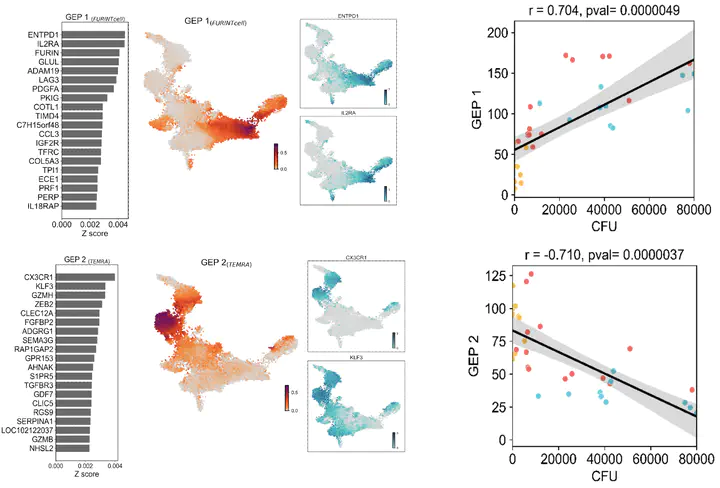 T cell correlates of immunologic control in Mtb-infected tissues
T cell correlates of immunologic control in Mtb-infected tissuesAbstract:
Mycobacterium tuberculosis (Mtb) and Mtb coinfections remain one of the leading causes of death due to infectious disease worldwide, causing ~1.5 million deaths every year [1]. T cell-mediated immunity is essential for containment of Mtb infections. Early murine and nonhuman primate (NHP) studies have illustrated that loss of CD4+ T cells abrogates control [2]. Here we sought to investigate how concomitant Mtb infection modulates host response to reinfection, and we assess the mechanisms by which CD4+ T cells coordinate the host’s immune response. Mtb-infected and uninvolved tissues from cynomolgus macaques were collected. The tissues were homogenized to measure bacterial burden and to generate single cell suspensions for singlecell RNA-seq. With the scRNA-seq data, we have detected gene expression programs, including cell identity programs and activity programs, that are differentially enriched across the non-human primate cohorts. Collectively, our data illustrate that CD4+ T cells are required for protection against Mtb reinfection, and cytotoxicity rather than cytokine secretion is in control of Mtb.
Some key findings:
GEP1 (FURIN T Cells) has gene signatures associated with T17 (IL18RAP, IL23R, IL2RA) and dysfunctional T cell responses (LAG3, ENTPD1, TIGIT, CTLA4) [3]. Enriched usage of GEP1 is correlated with high bacterial burden. This suggests that T17-like cellular activities and dysfunctional or exhausted T cells correlates with Mtb progression. GEP2 (TEMRA Cells) has gene signatures associated with vascular cytotoxic T cells (CX3CR1, KLF3, GZMH, S1PR5) [4]. Enriched usage of GEP2 is correlated with low bacterial burden. This suggests that the effector and memory CD8+ T cells help control Mtb, with CD4+ T cells potentially serve as a modulator. The correlational analyses from GEP1 and GEP2 suggest that CD4+ T cells are critical in modulating CD8+ T cell responses during reinfection, potentially helping the effector memory cells to recall responses from previous infections.
Reference:
- World Health Organization. (2013). Global tuberculosis report 2013. World Health Organization.
- Diedrich, C. R., Mattila, J. T., Klein, E., Janssen, C., Phuah, J., Sturgeon, T. J., … & Flynn, J. L. (2010). Reactivation of latent tuberculosis in cynomolgus macaques infected with SIV is associated with early peripheral T cell depletion and not virus load. PloS one, 5(3), e9611.
- Kotliar, D., Veres, A., Nagy, M. A., Tabrizi, S., Hodis, E., Melton, D. A., & Sabeti, P. C. (2019). Identifying gene expression programs of cell-type identity and cellular activity with single-cell RNA-Seq. Elife, 8, e43803.
- Li, H., van der Leun, A. M., Yofe, I., Lubling, Y., Gelbard-Solodkin, D., van Akkooi, A. C., … & Amit, I. (2019). Dysfunctional CD8 T cells form a proliferative, dynamically regulated compartment within human melanoma. Cell, 176(4), 775-789.